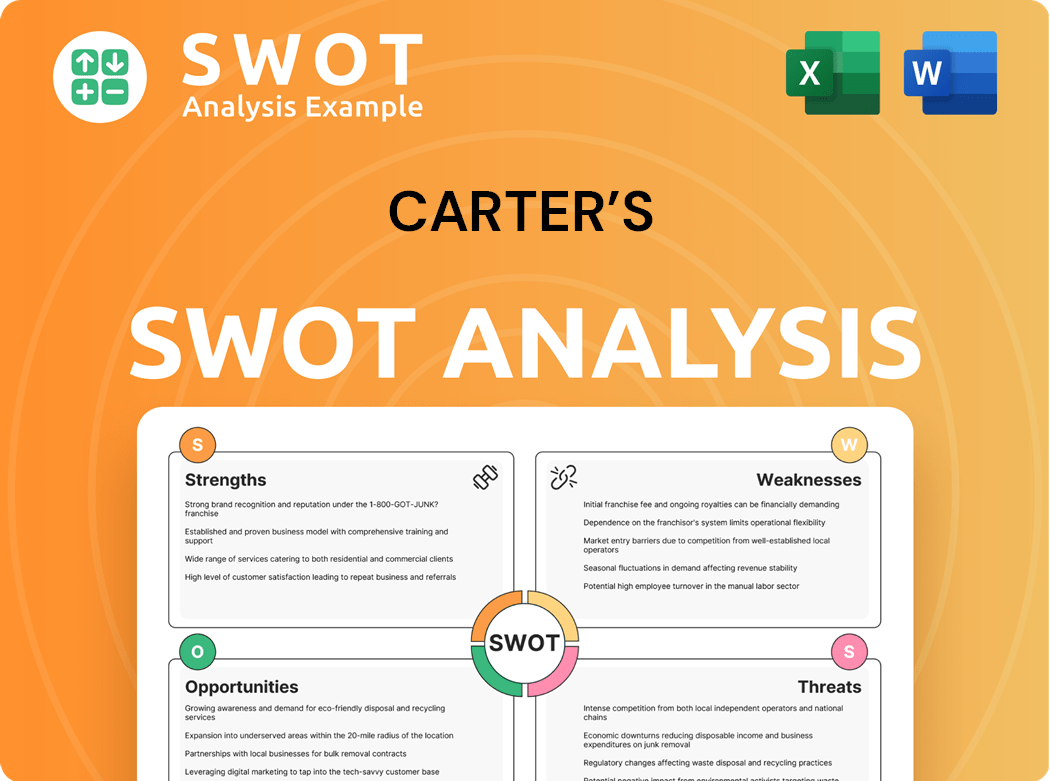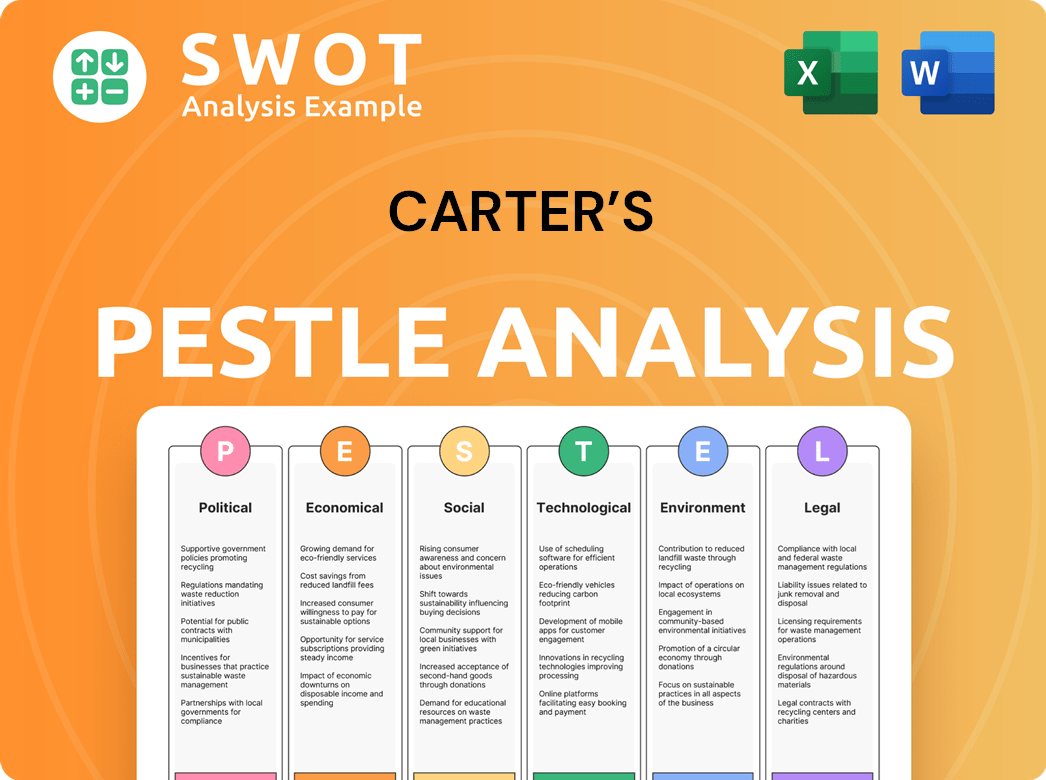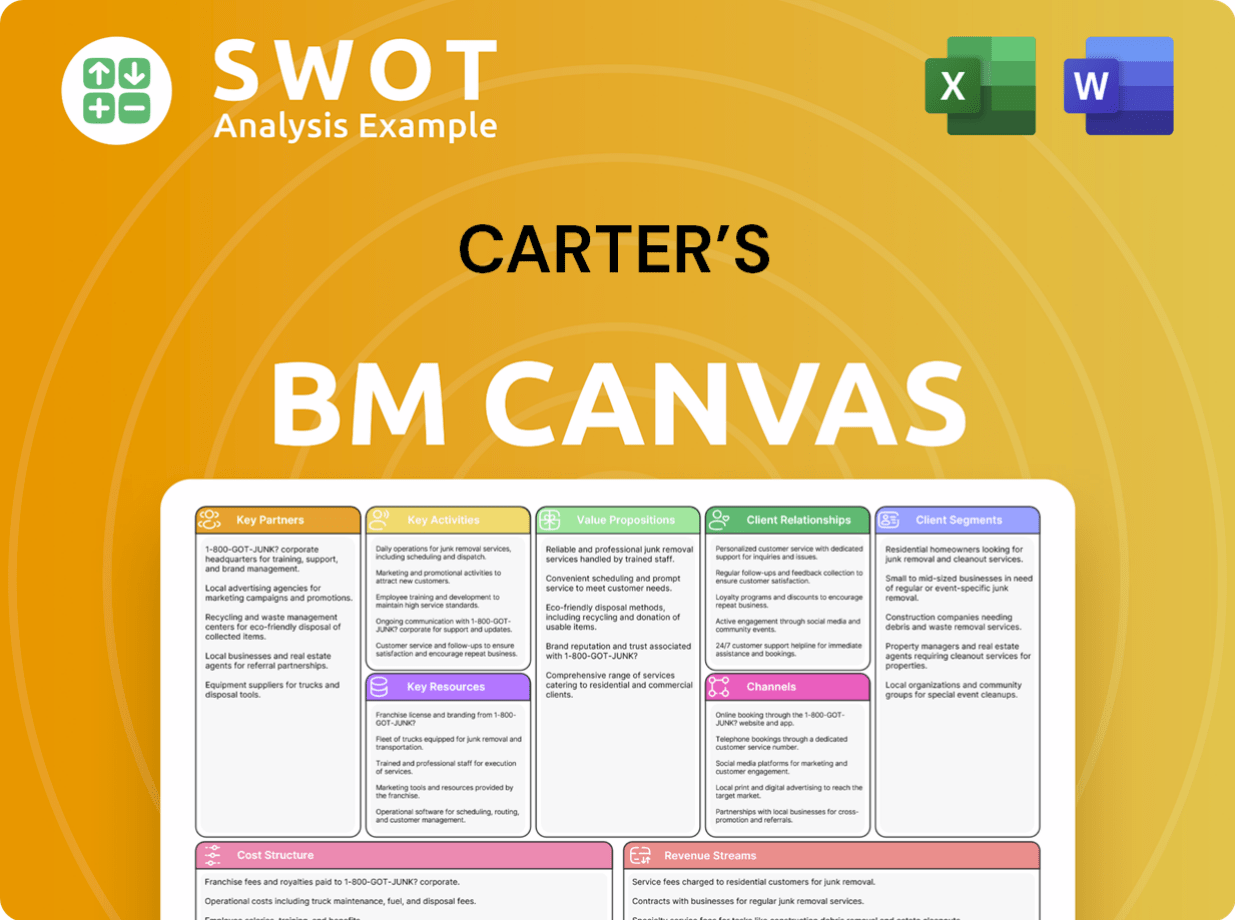Carter’s Bundle
Who Buys Carter's? Unveiling the Secrets of Their Customer Base
In the ever-evolving world of children's apparel, understanding customer demographics is key. For a company like Carter's, which has been a staple in the baby clothing market since 1865, adapting to shifting consumer behaviors is essential for sustained success. This analysis delves into the heart of Carter's customer base, exploring who they are and what drives their purchasing decisions.

As the retail demographics shift, particularly with the rise of Gen Z parents, Carter's has strategically positioned itself to meet their needs. This involves everything from product development to marketing campaigns. To gain a deeper understanding of Carter's strategic approach, consider a detailed Carter’s SWOT Analysis, which provides valuable insights into their strengths, weaknesses, opportunities, and threats. This exploration will reveal how Carter's is navigating the baby clothing market and maintaining its brand positioning.
Who Are Carter’s’s Main Customers?
Understanding the primary customer segments is crucial for any business, and for the baby and children's apparel industry, it's especially important. This analysis focuses on the customer demographics and target market of Carter's, a leading player in this sector. The company's strategic focus and marketing efforts are deeply intertwined with its understanding of its core customer base.
Carter's, Inc. primarily targets consumers (B2C), specializing in apparel and related products for babies and young children. The company's success is closely tied to its ability to understand and cater to the needs and preferences of parents. This includes a keen awareness of evolving trends in the baby clothing market and children's apparel.
The core demographic for Carter's is parents, with a significant and growing emphasis on Gen Z parents. By 2025, Gen Z parents are projected to constitute nearly two-thirds of expecting and new parents. This shift highlights the importance of adapting marketing and product strategies to resonate with this demographic. Understanding Carter's customer age range and their preferred clothing styles by age is key to their success.
The typical Carter's customer is often described as a mom with two young children and an income exceeding $80,000. These customers frequently shop for children's clothing, with many shopping six or more times a year. This frequent purchasing behavior underscores the importance of customer loyalty programs and understanding Carter's customer buying behavior.
While Carter's offers sizes from infant to size 14, the baby and toddler categories account for approximately 80% of its apparel sales. This indicates a strong focus on the youngest age groups. Despite declining birth rates, Carter's increased its market share in both the baby and toddler segments in 2024. This success reflects effective marketing strategies for target market.
Carter's recognizes the significant role of grandparents as a key demographic, understanding their influence on purchasing decisions. The company also serves businesses through its wholesale segment, being the largest supplier of young children's apparel to major retailers in North America, including Walmart (Child of Mine brand), Target (Just One You brand), and Amazon.com (Simple Joys brand).
Historically, Carter's catered to low- to middle-income households. However, analysis in 2024 indicates that Carter's has successfully attracted higher-income family segments, such as 'Wealthy Suburban Families' and 'Ultra Wealthy Families'. Their representation in Carter's captured market in 2024 (12.5% and 8.9% respectively) outpaced their presence in the company's potential market. This suggests a strategic shift or expansion, possibly driven by new product lines and a focus on value and style.
Carter's target market is primarily parents, with a growing emphasis on Gen Z parents. The company's focus on baby and toddler apparel, which makes up approximately 80% of its sales, highlights its core customer base. Carter's has successfully expanded its reach to higher-income families while maintaining its appeal to a broad customer base. To learn more about the company's history, read the Brief History of Carter’s.
- Parents, especially Gen Z parents, are the primary customer segment.
- The baby and toddler categories are the main focus, representing a significant portion of sales.
- Carter's has expanded its reach to include higher-income families.
- The company utilizes both direct-to-consumer and wholesale channels.
Carter’s SWOT Analysis
- Complete SWOT Breakdown
- Fully Customizable
- Editable in Excel & Word
- Professional Formatting
- Investor-Ready Format

What Do Carter’s’s Customers Want?
Understanding the customer needs and preferences is crucial for the success of any business, and this is especially true for the children's apparel market. The company, a well-known name in the baby clothing market, caters to a diverse customer base with specific needs and desires. These needs are shaped by practical considerations, emotional connections, and aspirational goals, all of which influence purchasing decisions.
The company's customer base is driven by the need for comfort, durability, and value, given that children quickly outgrow their clothes. The company's long-standing heritage, spanning nearly 160 years, has built a foundation of trust, making it a go-to choice for parents. This trust is essential in the children's apparel sector, where parents seek reliable and quality products for their children.
The company's customer demographics and target market include a wide range of parents, influenced by factors such as income, lifestyle, and values. The brand's ability to adapt to changing consumer preferences, particularly those of the rising Gen Z parents, is key to its continued success. This adaptability is demonstrated through its product development, marketing strategies, and customer engagement initiatives.
Customers prioritize comfort, durability, and value when purchasing children's apparel. These factors are crucial because children outgrow their clothes quickly. The company's focus on these elements ensures that its products meet the practical needs of parents.
Customers frequently replenish children's wardrobes, leading to multiple shopping trips per year. The company's customers typically shop six or more times annually. This high frequency underscores the importance of consistent product availability and appealing designs.
The brand caters to a broad range of income levels, with a focus on balancing quality and affordability. While it attracts low- to middle-income households, it also appeals to higher-income families. This broad appeal is a key aspect of the company's success.
Gen Z parents, who will constitute a significant portion of the customer base by 2025, prioritize sustainability, authenticity, and trend-forward styles. This demographic shift requires the company to adapt its product offerings and marketing strategies. The company is actively responding to these evolving preferences.
The company tailors its product development and marketing to meet the evolving needs of its customers. This includes the launch of sustainable product lines and campaigns that authentically portray modern parenthood. The company uses data and insights to inform its approach.
The company's loyalty program plays a crucial role in fostering customer loyalty, with over 90% of U.S. Retail sales transacted through it. The company is also planning to relaunch its KIDCYCLE™ clothing takeback program in 2025, aligning with the demand for ethical and sustainable products.
The company actively adapts to meet the changing needs of its customers, particularly the rising Gen Z parents. This adaptation involves product development, marketing, and customer engagement strategies. For instance, the company launched the Little Planet brand in 2021, focusing on organic fabrics and sustainable materials, and the PurelySoft by Carter's assortment in 2023, emphasizing soft and stretchy fabrics. To further understand its customer base, the company utilizes various methods.
- Product Development: Launching new brands and assortments, such as Little Planet and PurelySoft, to meet specific customer preferences for sustainability and comfort.
- Marketing Campaigns: Reimagining marketing creative and campaigns to authentically portray modern parenthood, such as the 'More Than Just Cute' campaign.
- Data and Insights: Using data from focus groups, surveys, and social listening to inform its approach and ensure it meets changing consumer preferences.
- Loyalty Programs: Relaunching its loyalty program, with over 90% of U.S. Retail sales transacted through it, to foster customer loyalty.
- Sustainability Initiatives: Planning to relaunch its KIDCYCLE™ clothing takeback program in 2025, aligning with growing consumer demand for ethical and sustainable products.
For a deeper dive into the company's strategic moves, including its mission and growth strategies, consider reading the article on Growth Strategy of Carter’s.
Carter’s PESTLE Analysis
- Covers All 6 PESTLE Categories
- No Research Needed – Save Hours of Work
- Built by Experts, Trusted by Consultants
- Instant Download, Ready to Use
- 100% Editable, Fully Customizable

Where does Carter’s operate?
The geographical market presence of the company is primarily focused on North America. The company operates a vast network of over 1,000 company-operated stores across the United States, Canada, and Mexico. This extensive retail footprint is a key element of its strategy to reach its target market effectively.
Beyond its direct retail operations, the company leverages a robust wholesale business model. It serves as the largest supplier of young children's apparel to major retailers throughout North America. This includes partnerships with department stores, national chains, and specialty retailers, as well as brands sold at mass-market retailers and online platforms, expanding its reach to a broader customer base.
In 2024, the company saw continued growth in its retail businesses in Mexico and Canada. While the U.S. Retail and International segments experienced declines in net sales in fiscal year 2024, the U.S. Wholesale segment showed growth, partially offsetting these declines. In the first quarter of fiscal 2025, demand outside the United States remained strong, particularly in the Canadian and Mexican retail businesses, with Canadian comparable net sales increasing by 4.7% due to increased traffic and favorable competitive conditions.
The company is actively adapting its offerings and marketing strategies to succeed in diverse markets. While overall international sales were impacted by currency exchange rates in the first quarter of fiscal 2025, the growth in Canada highlights localized success. This demonstrates the company's ability to tailor its approach to specific regional demands.
- The company plans to open 200 U.S. stores by 2030.
- 40 new stores are planned for 2024.
- The company is focusing on high-traffic areas, including 'Blue Collar Suburbs'.
- This expansion aims to enhance customer acquisition and loyalty.
Carter’s Business Model Canvas
- Complete 9-Block Business Model Canvas
- Effortlessly Communicate Your Business Strategy
- Investor-Ready BMC Format
- 100% Editable and Customizable
- Clear and Structured Layout

How Does Carter’s Win & Keep Customers?
To attract and keep customers, the company uses a range of strategies. These include digital marketing, traditional methods, social media, and working with influencers, especially targeting Gen Z parents. For example, the company showcased its Spring-Summer 2025 collections during New York Fashion Week in February 2025, which resulted in 6.6 million social media impressions.
The company has improved its customer acquisition and retention rates. This is due to investments in pricing, marketing, and retail stores. The company has also introduced new online personalization features to boost sales and strengthen customer relationships. A key part of this is the loyalty program, which was updated in 2024. Over 90% of U.S. Retail sales are through this program, showing its importance in building customer loyalty.
The company uses discount pricing strategies to attract customers. It also plans to open 200 stores in the U.S. by 2030, including 40 new stores in 2024, while closing 30 underperforming ones. The company is also focused on creating an engaging in-store experience. This includes a reimagined retail concept with a Mothers' Lounge and a Kid Interactive Zone, which started in Atlanta in October 2024, with plans for nationwide expansion by 2026. The company's commitment to corporate social responsibility, including its 2024 Raise the Future Impact Report highlighting sustainability efforts and community investments, also plays a role in attracting environmentally conscious consumers and enhancing brand reputation.
The company utilizes a robust digital marketing strategy to reach its target market. This includes social media campaigns, targeted advertising, and search engine optimization (SEO). This helps to increase brand visibility and drive online sales.
Traditional marketing methods, such as print advertisements and direct mail, are still used. These methods help to reach a broader audience, including those who may not be active online. This is especially important for the baby clothing market.
Social media platforms are key for engaging with the target audience, with a focus on Gen Z parents. The company runs interactive campaigns, contests, and influencer collaborations. This increases brand awareness and customer engagement, which is crucial in the children's apparel sector.
Collaborations with social media influencers are a significant part of the strategy. These influencers promote products to their followers, which boosts sales and brand recognition. The company's fashion week showcase is a prime example.
The company's loyalty program is a major retention tool. The program, which was revamped in 2024, offers exclusive benefits and rewards to returning customers. This drives repeat purchases and builds customer loyalty. This is important for understanding the retail demographics.
The company is enhancing the in-store experience to attract and retain customers. New store concepts include features like Mothers' Lounges and Kid Interactive Zones. These concepts are designed to make shopping more enjoyable and convenient.
Several key strategies are used to acquire and retain customers. These strategies focus on creating a positive customer experience and building long-term relationships.
- Personalization: Offering personalized products and experiences online.
- Pricing Strategies: Using discounts and promotions to attract customers.
- Store Expansion: Expanding the physical store footprint to reach more customers.
- Customer Engagement: Creating engaging in-store experiences and online interactions.
- Loyalty Programs: Rewarding repeat customers through a revamped loyalty program.
The company's customer acquisition and retention strategies have a significant impact on its financial performance. These strategies help to increase sales, improve customer loyalty, and drive overall growth. For further insights into the financial aspects, consider reading about the Revenue Streams & Business Model of Carter’s.
- Increased Sales: Driving higher sales through effective marketing and promotions.
- Enhanced Loyalty: Building customer loyalty through rewards programs and personalized experiences.
- Brand Reputation: Improving brand reputation through corporate social responsibility efforts.
- Market Expansion: Supporting market expansion through new store openings and online growth.
Carter’s Porter's Five Forces Analysis
- Covers All 5 Competitive Forces in Detail
- Structured for Consultants, Students, and Founders
- 100% Editable in Microsoft Word & Excel
- Instant Digital Download – Use Immediately
- Compatible with Mac & PC – Fully Unlocked

Related Blogs
- What are Mission Vision & Core Values of Carter’s Company?
- What is Competitive Landscape of Carter’s Company?
- What is Growth Strategy and Future Prospects of Carter’s Company?
- How Does Carter’s Company Work?
- What is Sales and Marketing Strategy of Carter’s Company?
- What is Brief History of Carter’s Company?
- Who Owns Carter’s Company?
Disclaimer
All information, articles, and product details provided on this website are for general informational and educational purposes only. We do not claim any ownership over, nor do we intend to infringe upon, any trademarks, copyrights, logos, brand names, or other intellectual property mentioned or depicted on this site. Such intellectual property remains the property of its respective owners, and any references here are made solely for identification or informational purposes, without implying any affiliation, endorsement, or partnership.
We make no representations or warranties, express or implied, regarding the accuracy, completeness, or suitability of any content or products presented. Nothing on this website should be construed as legal, tax, investment, financial, medical, or other professional advice. In addition, no part of this site—including articles or product references—constitutes a solicitation, recommendation, endorsement, advertisement, or offer to buy or sell any securities, franchises, or other financial instruments, particularly in jurisdictions where such activity would be unlawful.
All content is of a general nature and may not address the specific circumstances of any individual or entity. It is not a substitute for professional advice or services. Any actions you take based on the information provided here are strictly at your own risk. You accept full responsibility for any decisions or outcomes arising from your use of this website and agree to release us from any liability in connection with your use of, or reliance upon, the content or products found herein.